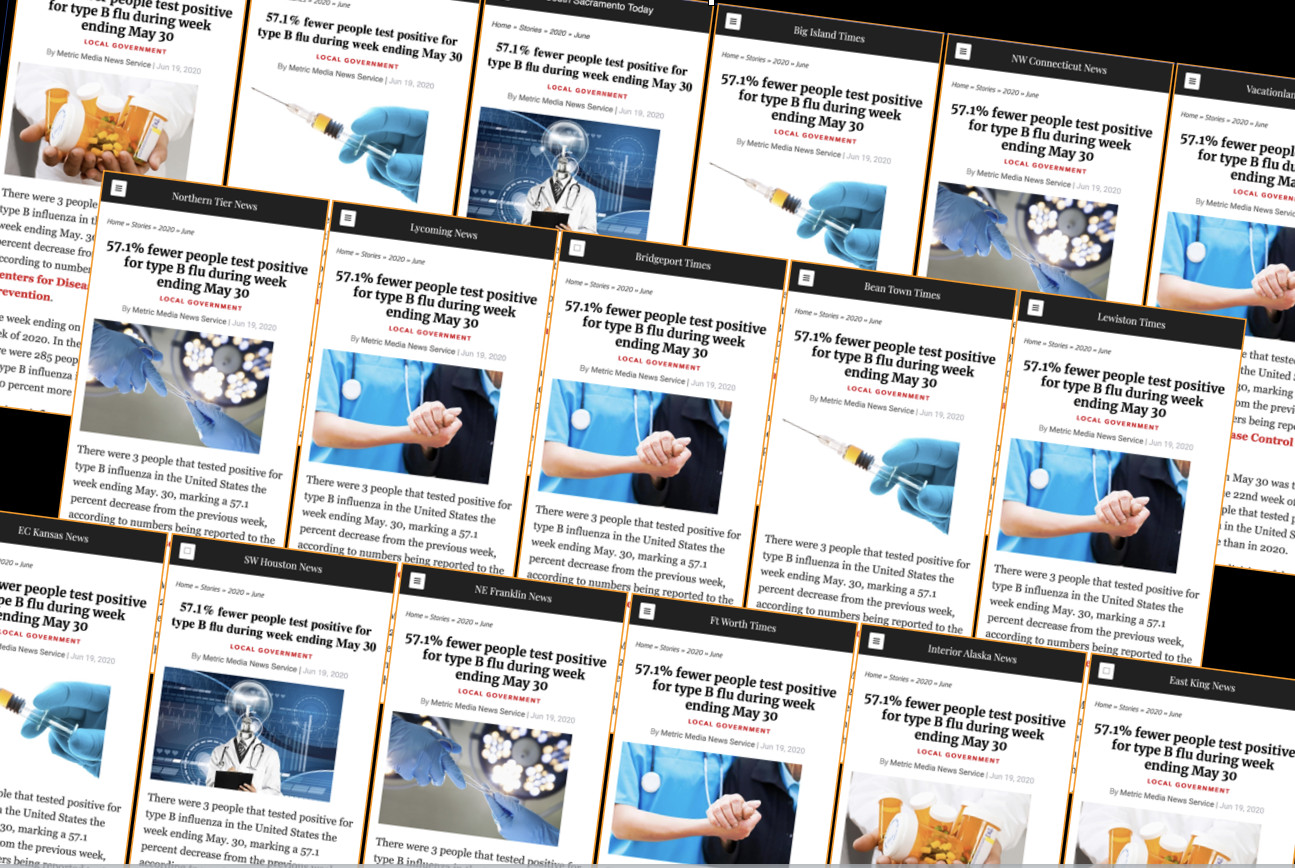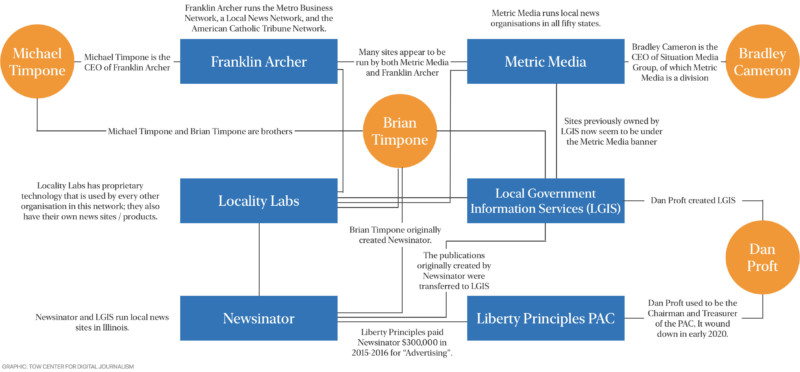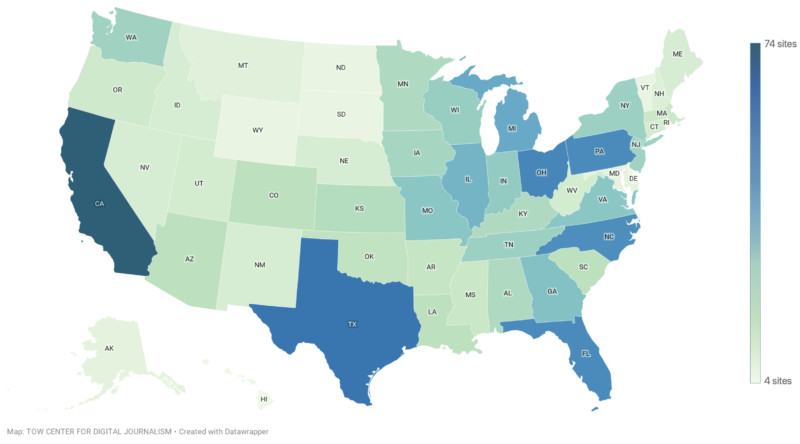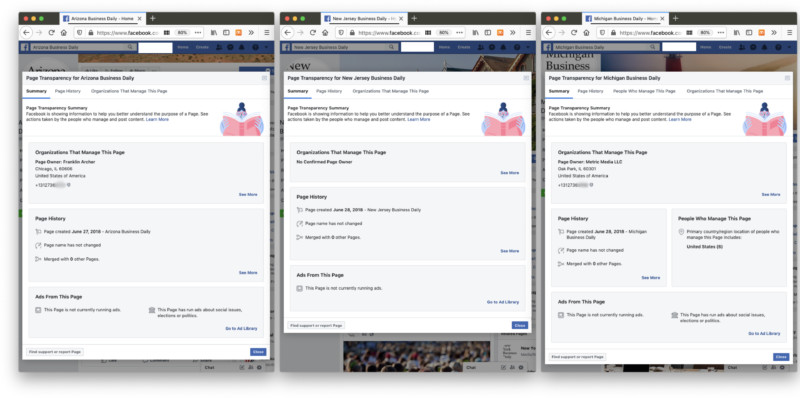Editor’s Note: This is the second of our four pieces on this network. In December 2019, we first established the scope of the “pink slime” network distributing algorithmic stories and conservative talking points. In October 2021, we found that the network had received funding from multiple dark money groups as well as collaborated with advocacy groups on topics to cover prior to the 2020 Election.
The run-up to the 2020 November elections in the US has produced new networks of shadowy, politically backed “local news websites” designed to promote partisan talking points and collect user data. In December 2019, the Tow Center for Digital Journalism reported on an intricately linked network of 450 sites purporting to be local or business news publications. New research from the Tow Center shows the size of that network has increased almost threefold over the course of 2020, to over 1,200 sites.
Identifying these new sites is a result of further analysis of the closely linked entities with conservative ties illustrated in Figure 1 (below). The Tow Center focused predominantly on Metric Media, Franklin Archer, Local Government Information Services (LGIS), and Locality Labs. Both Metric Media and Franklin Archer claim to be the largest local news provider in the US, though many of their sites have low visibility in both search and social media. Over 90 percent of their stories are algorithmically generated using publicly available data sets or by repurposing stories from legitimate sources. In the remaining stories that have an authentic byline, there is often a conservative bent. As reported by the Lansing State Journal and The Guardian, this includes articles about voter fraud using data from the Heritage Foundation, negative pieces about elected Democratic representatives, and stories supporting conservative candidates. This low-cost automated story generation has come to be known as pink slime journalism. In addition to the hundreds of titles that ape the look and feel of local news, our research has detected new sites in this network that address single subjects, appeal to religious orientation, and focus on business news.
The recent increase in activity is in line with the election cycle. It is becoming an increasingly common campaign strategy for pacs and single-interest lobbyists to fund websites that borrow credibility from news design to help advance particular agendas. The proliferation of politically funded local news sites across the political spectrum raises questions about how these entities represent themselves to the public, and how they are categorized by search engines and social platforms.
The number of news media properties funded by often obscure political interests has been growing for years and will reach a new peak in the 2020 election cycle. A recent report from Open Secrets highlighted “dark money” networks funded by liberal-leaning donors. Academics Jessica Mahone and Phil Napoli recently plotted some of these known entities on a map to show the geographic concentration of the networks. But the definitions of what constitutes a politically funded network are hard to establish, particularly if the financial and ownership structures are not clear. A recent report from Politico outlined how Courier Newsroom, a group of politically affiliated local news sites, was spending large amounts of advertising money on Facebook on articles promoting Democratic candidates. Establishing how politically funded networks are intrinsically different from news organizations with strong political affiliations, such as Breitbart or Fox News, can be a tall order. Politically funded networks can appear on Facebook pages classified as “Media/News company,” and articles from partisan sites are indexed by Google News.
Today, along with further analysis of this network, we are publishing the full list of websites, the geographic focus of each publication where one exists, and the corresponding organizational entity each site belongs to. However, due to the convoluted connections between these organizations, precise ownership is difficult to establish. Often a site will carry different information about its provenance on its “About” page, its Facebook page, and in the terms and conditions it publishes on its own site.
The overlapping networks seem designed to confuse casual observers as to their origins and ownership, and delineations between them are fuzzy. The publishers involved are incorporated in different states, have different business models, and provide different services. However, they all share certain distinguishing traits that suggest close overlapping relationships, such as the same authors, story templates, analytics identifiers, and other technological resources.
To identify these new sites and the evolution of the networks, we adopted the same techniques we used for our investigation in December, relying heavily on third-party tools like RiskIQ and Farsight DNSDB.
In our latest research, we found the vast majority of the domains were under the umbrella of Metric Media, a Delaware limited-liability company that is a division of Situation Management Group. Metric Media properties now account for over 960 sites, or 80 percent of all the domains we’ve identified that belong to this network. All publishing is done “under a licensing agreement with the Metric Media Foundation, a 501(c)(3) non-profit news content provider.”
Over seven hundred of these local sites have been activated in 2020, pointing to a sharp acceleration in the lead-up to the November elections. The new activity has seen a host of titles, such as the Philly Leader and San Francisco Sun, added to the network, with the number of states expanding from ten to all but one. (While Metric Media doesn’t have any titles for Illinois, LGIS does.)
Beyond Metric Media’s rapid expansion, our research showed that Franklin Archer had also expanded the number of networks under its umbrella. The organization boasts that it is “the largest producer of local news in the United States,” with better than two hundred active websites and two networks: Metro Business Network and Local News Network. A third, the American Catholic Tribune Media Network, was created in March 2020. There are currently six sites in the network, including the American Catholic Tribune. Further, Franklin Archer products now also include a handful of stand-alone titles that are either single-subject (e.g., Current Science Daily) or geographically focused on specific towns or neighborhoods (e.g., West Loop Today), as well as two podcasts hosted by the Freedom Media Network. Franklin Archer also lists public relations activities on its website, where user testimonials boast about the effectiveness of sponsored content as a marketing tool.
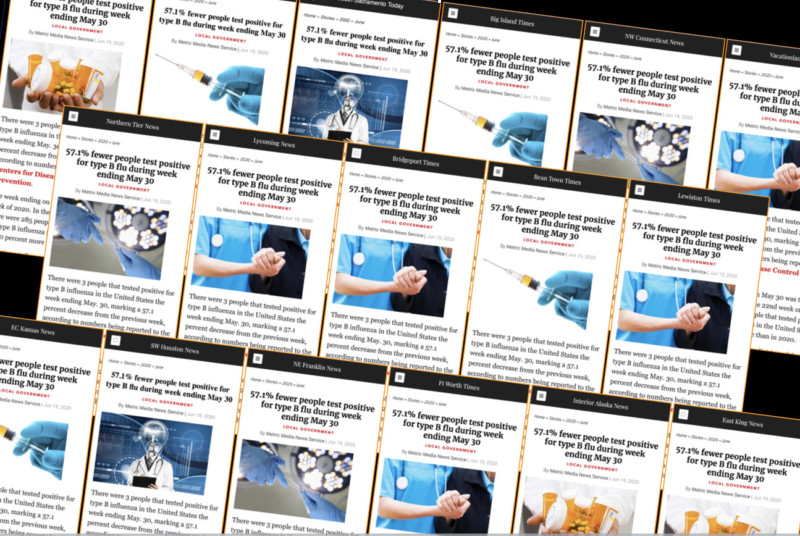
Figure 2: A single algorithmically generated story with different stock photography that appeared across over 850 domains
Evolution and Sprawl of the Network in 2020
The bulk of sites that went live in 2020 are under the Metric Media banner. In 2019, when we were first looking at Metric Media, its stated goal was to launch “hundreds [of sites] nationwide to inform citizens about news in their local communities.” Today, the language on the same page indicates it has reached the goal of creating “hundreds” of sites. A website lists its publications by state, along with a one-line explanation of what the company is: “a digital firm managing the online presence of the portfolio of local news sites known as Metric Media.” Based on passive DNS data (RiskIQ and DNSDB Scout), by the end of January 2020, Metric Media had publications devoted to all but one of the forty states that weren’t already covered in 2019; the domains for these were registered in the second half of 2019. The one exception was Illinois, which we cover in more detail further down.
Some sites cover entire states, whereas others are devoted to specific cities and metropolitan areas. The nomenclature is often formulaic, combining compass directions with the names of the states or cities and then generic terms for news publications. Site names include SW Oklahoma News, NE Ohio Times, and West SFV Today (in California’s San Fernando Valley). Many major cities get their own “wire” publication: Detroit City Wire, Dallas City Wire, Seattle City Wire.
Figure 3 illustrates the number of publications present in each state. Rhode Island has the fewest devoted to it (four), California the most (seventy-four). We didn’t find any publications for either of these two states in 2019; in fact, we only found Metric Media properties in ten states then. Now there are sites covering forty-nine states; only Illinois and Washington, DC, are absent from the Metric Media network.
The absence of Illinois publications may have a relatively simple explanation: LGIS, a stand-alone corporation devoted to covering Illinois since 2015, is part of the extended network, with connections to Metric Media. LGIS has ties to conservative figures in the state, including Dan Proft and Brian Timpone. Proft, who through his pacs has raised millions to back conservative candidates in Illinois, shut down two pacs earlier this year. Timpone has a long history creating businesses focusing on automated low-cost journalism (or “pink slime” journalism), including the controversial Journatic and its successor Locality Labs. Locality Labs appears to be the organization creating the technology that allows for the automation of news stories using publicly available data sets across this entire ecosystem of 1,200 websites. One of Proft’s now-shuttered pacs has paid one of Timpone’s other companies, Newsinator, for “Advertising – newspaper,” according to campaign finance records.
Until December, the About Us page of the Illinois sites stated they were a “product of LGIS—Local Government Information Services,” while the Terms of Service and Privacy pages indicated they were properties of Locality Labs LLC. As of March, however, the Terms of Service and Privacy pages are blank. The language on their About Us pages hasn’t changed, maintaining that the sites are part of LGIS and funded in part “by advocacy groups who share our beliefs in limited government.” (Most of the Illinois websites have similar language in their About Us pages, where they mention details specific to the publication, and then details about the objectives of LGIS and its funding. However, for some sites, like the Grundy Reporter and Southern Illinois News, the About Us pages have been blank since at least last year, based on snapshots in the Internet Archive.)
In March, these Illinois sites adopted the same website theme (and thus the same look and feel) as the sites that Metric Media explicitly states it runs.
Additionally, Metric Media has at least two single-subject sites: Insurance Rate Reporter and Education Daily Wire. The About Us page for the former is blank, but its Privacy Policy and Terms of Service pages say the site is operated by Metric Media LLC. Education Daily Wire’s Privacy and Terms of Service pages are blank, but its About Us page says it’s funded by the Metric Media Foundation. These publications are not mentioned on either Metric Media website: the LLC or the foundation.
Also absent from any Metric Media website are the fifty-one Metro Business Network publications operated by Metric Media LLC, per their privacy policies and terms of service. According to the Metro Business Network site, these publications “aim to cover news from Fortune 500’s to SMB’s on Main Street [sic].” While the site does not mention anything about the ownership or funding of these publications, the Privacy Policy and Terms pages state that the network is operated by Locality Labs.
Tracing the ownership of sites within the network is made more complicated by how the sites label themselves on Facebook. The Facebook pages for the business news sites include information about the page owner, which is where information about news and media properties on the platform can be found. However, sites within the same subnetwork (Metro Business Network, in this case) have different confirmed page owners, and in a handful of cases, no confirmed owner at all. Those with confirmed page ownership are split between Franklin Archer and Metric Media, and while the addresses for the two owners are different, their phone number is the same. The social presence of the network is very small, with negligible interactions (followers, likes, and shares) on each page.
Franklin Archer, a fictitious name for Iowa-incorporated DirecTech LLC, “brings coverage to underreported areas of American life,” according to its website. It has two networks: the “Metro Business Daily Network” and the “Local News Network.” As reported by The Guardian, the CEO of Franklin Archer is Timpone’s brother, Michael Timpone. On the corporate front, the relationship between Metric Media LLC and Franklin Archer remains unclear, but they appear to share not only technology resources and authors, but also the publications themselves. To wit, as can be seen below in Figure 4: at the time of writing, the Arizona Business Daily is owned by Franklin Archer, according to Facebook, and the Michigan Business Daily by Metric Media LLC. The New Jersey Business Daily has no confirmed page owner.
In 2020, a third network was added to the Franklin Archer portfolio, although it is not mentioned on its website: the American Catholic Tribune Media Network, which includes five state-specific publications (in Wisconsin, Minnesota, Michigan, Florida, and Arizona) and one national one (the American Catholic Tribune). These sites relay information about parishes and churches, including updates on how various churches intend to conduct Mass every week. Earlier this year, the sites mentioned they are “a product of Franklin Archer,” but that disclaimer no longer exists. Their Facebook pages, however, state they are owned by Franklin Archer.
These sites follow the exact same model as all the other sites in the extended network: rewrite original reporting from existing sources, including diocesan newspapers; repurpose announcements (including Mass timings and homilies) published by various churches under the guise of “press release submissions”; and sprinkle on some original reporting.
Yet another new product of Franklin Archer is the Freedom Media Network, which hosts podcasts and a YouTube channel with just under a thousand subscribers. The channel is described as “your source for positive news and content aimed at helping you become more purposeful, productive, and prosperous.” One of the podcasts, Freedom Mindset Radio, is rife with anti-science positions, including the suggestion that getting a diagnosis is dangerous, as “they’re labeling a bag of symptoms.” The YouTube videos started being uploaded in January, and the website went live in March.
One-off sites continue to be created alongside these dedicated networks and channels. Sites created since our last investigation include the Neighbourhood Guardian, West Loop Today, the Midland Times, and Current Science Daily.
If you have examples of similar networks operating in your area or would like access to more granular data, please get in touch with us here.
Priyanjana Bengani is a Tow Computational Fellow at Columbia Journalism School's Tow Center for Digital Journalism.

